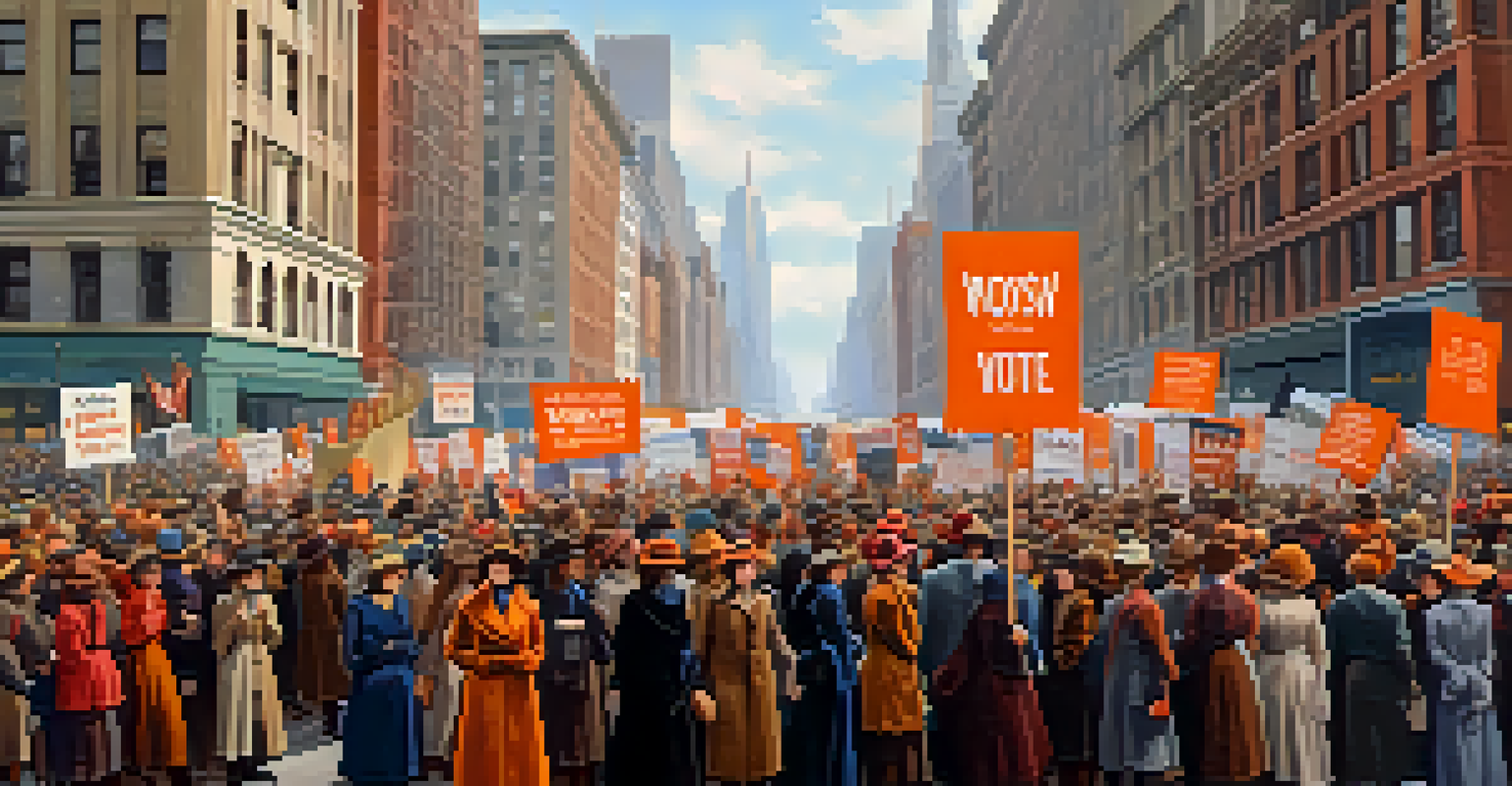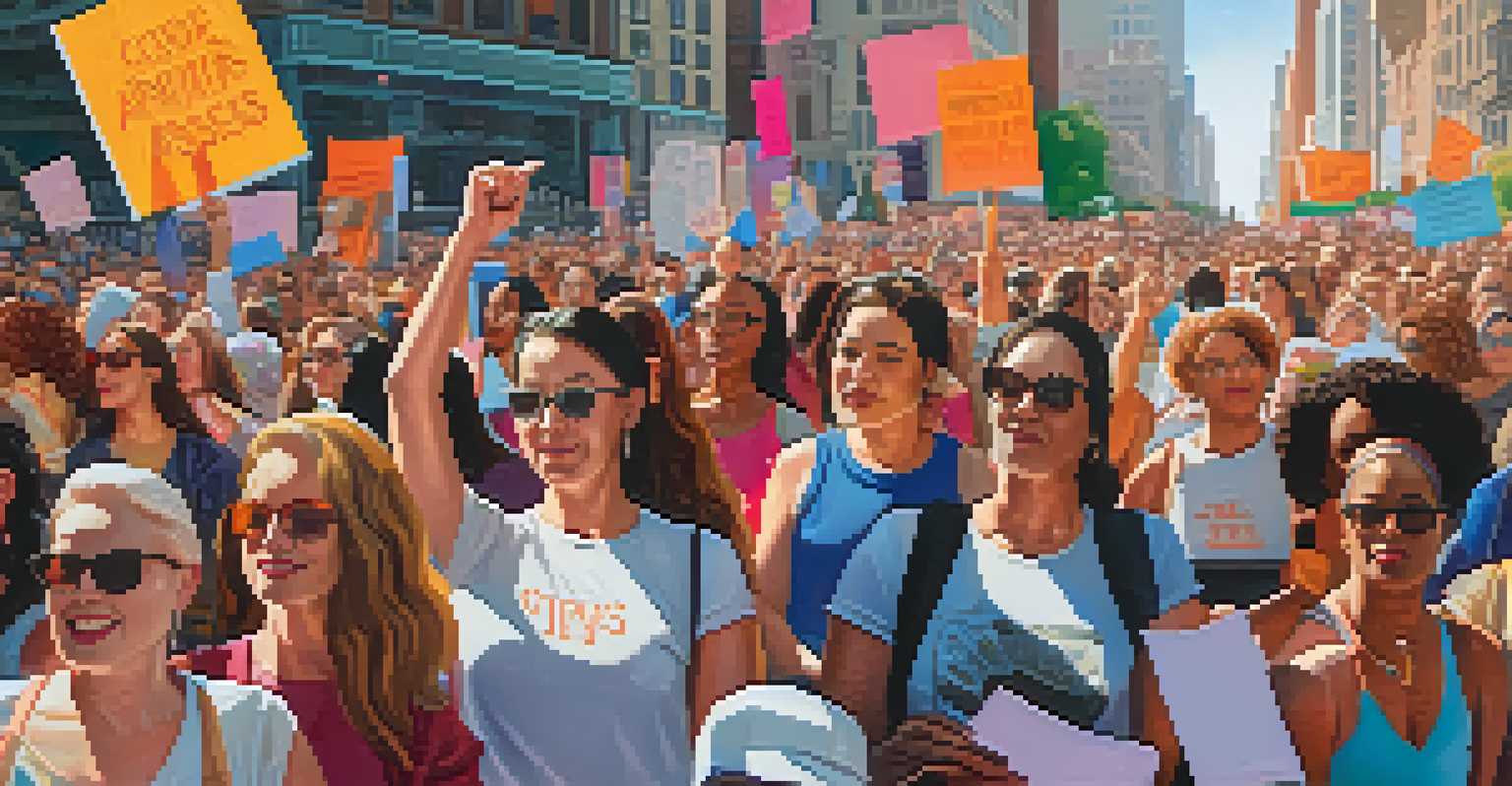The Birth of Modern Feminism: NYC's Influence on Women's Rights

The Seeds of Feminism: Early Movements in NYC
In the early 19th century, New York City became a hotbed for social reform, including the early feminist movement. Activists like Elizabeth Cady Stanton and Lucretia Mott gathered in cities, advocating for women's rights amidst the backdrop of the abolitionist movement. Their efforts laid the groundwork for future activism by highlighting the importance of gender equality.
The truth will set you free, but first it will make you miserable.
These early feminists organized the Seneca Falls Convention in 1848, which is often heralded as the birthplace of the women's rights movement. Here, the Declaration of Sentiments was drafted, calling for equal rights and opportunities for women, including the right to vote. This monumental event sparked discussions that would resonate throughout the country.
New York's unique cultural and social climate during this period fostered a spirit of activism and change. With its diverse population and burgeoning economy, the city became a melting pot for ideas, allowing women to gather, collaborate, and push for reforms that would eventually shape modern feminism.
The Suffrage Movement: NYC's Pivotal Role
As the suffrage movement gained momentum in the late 19th and early 20th centuries, New York City played a crucial role in rallying support for women's voting rights. Organizations such as the Women's Trade Union League and the National American Woman Suffrage Association held meetings and marches in the city, mobilizing thousands of women. Their determination and unity helped amplify the message of suffrage across the nation.

One significant event was the 1917 Women’s March on New York, where thousands of women marched to demand the right to vote. This demonstration showcased the power of collective action and drew attention to the injustices faced by women. The visibility of these protests in a bustling metropolis like NYC helped garner national media coverage and support.
NYC's Role in Early Feminism
New York City was a crucial hub for early feminist activism, highlighted by the Seneca Falls Convention and the efforts of pioneers like Elizabeth Cady Stanton.
Ultimately, New York's activism contributed to the passing of the 19th Amendment in 1920, granting women the right to vote. The city’s role in this historic achievement exemplified how local movements can influence broader social change, inspiring future generations of feminists to continue the fight for equality.
The Intersection of Feminism and Labor Rights
In the early 20th century, New York City became a focal point for the intersection of feminism and labor rights. Women, particularly immigrants, began organizing for better working conditions, fair wages, and the right to unionize. The tragic Triangle Shirtwaist Factory fire in 1911 served as a catalyst for labor reform, highlighting the dire need for protections for working women.
Feminism is for everybody.
Activists like Rose Schneiderman and Frances Perkins emerged as strong voices advocating for labor rights and workplace safety. Their efforts not only focused on the rights of workers but also emphasized the need for gender equality in the workforce. This connection between labor and feminism illustrated how economic empowerment was essential for achieving broader social change.
New York's bustling economy and diverse workforce made it an ideal setting for these movements to flourish. The collaboration between labor activists and feminists ultimately laid the groundwork for policies that would benefit women in the workplace for decades to come.
The Cultural Revolution: Feminism in Art and Media
During the 1960s and 70s, NYC became a cultural epicenter for the feminist movement, influencing art, literature, and media. Artists like Judy Chicago and the Guerrilla Girls used their platforms to challenge traditional gender roles and advocate for women's rights. Their provocative art pieces sparked dialogue and encouraged viewers to reconsider societal norms.
Literature also played a significant role in shaping feminist discourse, with authors such as Audre Lorde and Gloria Steinem emerging from the vibrant New York literary scene. Their writings addressed issues of race, gender, and sexuality, broadening the feminist narrative and making it more inclusive. This cultural revolution underscored the importance of diverse voices in the ongoing fight for equality.
NYC's Role in Early Feminism
Activists like Stanton and Mott laid the groundwork for women's rights in NYC, leading to significant events like the Seneca Falls Convention.
As feminist themes permeated mainstream media, they began to reshape public perceptions of women’s roles in society. Television shows, films, and music started to reflect the complexities of women’s experiences, contributing to a cultural shift that embraced feminism as a vital aspect of modern life.
The Rise of Intersectional Feminism in NYC
By the late 20th century, the feminist movement in New York City began to embrace intersectionality, recognizing that women's experiences are shaped by multiple identities, including race, class, and sexuality. Activists like Kimberlé Crenshaw highlighted the importance of considering these intersecting factors in the fight for equality. This shift allowed feminism to become more inclusive and representative of diverse experiences.
Organizations like the Third Wave Foundation emerged to advocate for younger feminists and address issues affecting marginalized communities. They focused on issues such as reproductive rights, domestic violence, and LGBTQ+ rights, expanding the scope of feminist activism in NYC. This inclusivity has helped to unite various movements, creating a comprehensive approach to social justice.
New York's diverse population provided a rich tapestry of voices and perspectives that fueled this evolution. The city became a laboratory for testing new ideas, allowing intersectional feminism to thrive and challenge traditional feminist narratives.
Modern Feminism: NYC as a Global Influence
Today, New York City continues to shape modern feminism on a global scale. With its vibrant community of activists, artists, and thinkers, the city serves as a hub for feminist discourse and action. Events like the Women's March and various rallies showcase the ongoing commitment to gender equality and social justice.
Moreover, organizations based in NYC, such as Planned Parenthood and the Ms. Foundation for Women, work tirelessly to advocate for women's rights and health access. Their initiatives often set the standard for feminist efforts worldwide, demonstrating the city's significant impact on global feminism.
Intersection of Feminism and Labor
The Triangle Shirtwaist Factory fire catalyzed a movement for labor rights and gender equality, highlighting the need for protections for working women.
As women around the world continue to fight for their rights, NYC remains a beacon of hope and solidarity. The city’s rich history of activism inspires new generations to engage in the feminist movement, ensuring that the fight for equality remains alive and vibrant.
The Future of Feminism: NYC's Ongoing Legacy
Looking ahead, the legacy of feminism in New York City will undoubtedly influence future generations of activists. The foundations laid by earlier feminists serve as a reminder of the importance of perseverance and collaboration in the pursuit of gender equality. As new challenges arise, the city’s history of activism will guide the next wave of feminists.
Moreover, the rise of digital activism offers exciting opportunities for engagement and outreach. Social media platforms allow activists to connect, share ideas, and mobilize quickly, expanding the reach of feminist movements beyond physical boundaries. NYC's tech-savvy environment positions it as a leader in this new form of activism.

As we move forward, it’s crucial to honor the achievements of those who paved the way while remaining adaptable to the ever-changing landscape of social justice. New York City’s role in the birth of modern feminism will continue to inspire and empower individuals to advocate for a more equitable world.